

World War One Research and Empathy Task. The Australian Home Front during World War 1 - Government powers. Government powers The war saw governments take on new and wide powers over aspects of people’s lives.
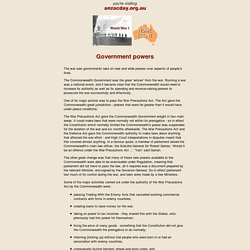
The Commonwealth Government was the great ‘winner’ from the war. Running a war was a national event, and it became clear that the Commonwealth would need to increase its authority as well as its spending and revenue-raising powers to prosecute the war successfully and effectively. One of its major actions was to pass the War Precautions Act. The Act gave the Commonwealth great jurisdiction - powers that were far greater than it would have under peace conditions.
German internees in WWI Australia. From the 1850s German settlers escaping the rising nationalist sentiment in Germany began arriving in the Australian colonies looking to start a new life.
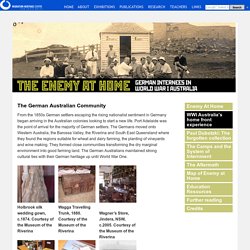
Port Adelaide was the point of arrival for the majority of German settlers. The Germans moved onto Western Australia, the Barossa Valley, the Riverina and South East Queensland where they found the regions suitable for wheat and dairy farming, the planting of vineyards and wine making. They formed close communities transforming the dry marginal environment into good farming land. The German Australians maintained strong cultural ties with their German heritage up until World War One.
Holbrook silk wedding gown, c.1874. Wagga Travelling Trunk, 1880. Wagner’s Store, Jindera, NSW, c.2005. German Noodle Cutter, c.1880s. Noodle Cutter detail. Internment camps - World War I and Australia - Research guides at State Library of New South Wales. During the war almost 7000 people were interned by the Australian government in the interest of national security.
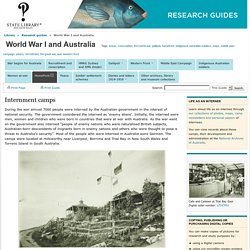
The government considered the interned as ‘enemy aliens’. Initially, the interned were men, women and children who were born in countries that were at war with Australia. As the war went on the government also interned “people of enemy nations who were naturalised British subjects, Australian-born descendants of migrants born in enemy nations and others who were thought to pose a threat to Australia's security”. Most of the people who were interned in Australia were German. The camps were located at Holsworthy near Liverpool, Berrima and Trial Bay in New South Wales and Torrens Island in South Australia. Prisoner of war quarters, Trial BayDigital order number: a7247015 ReferenceWartime internment camps in Australia. < 6 November 2013 Camp publications. World War I. Australia - The Enemy at Home - Goethe-Institut. Even though the first World War is considered one of the most important episodes in Australian history, dramatic events occurred during this time which have all but disappeared from the collective memory.
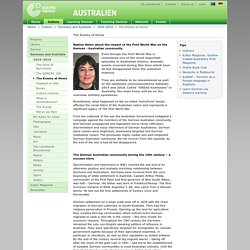
They are unlikely to be remembered as part of the centenary commemorations between 2014 and 2018. Arguments over conscription. While 50,000 men had signed up before the end of 1914 — a rate of more than 10,000 each month — the numbers of enlisting fell to 6,000 for the month of the Gallipoli landing in April 1915.
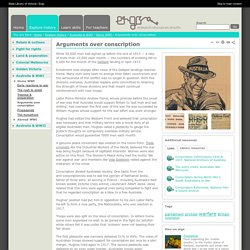
Enlistment rose sharply after news of the Gallipoli landings reached home. Many men were keen to avenge their fallen countrymen and the seriousness of the conflict was no longer in question. With five divisions overseas, Australian leaders were committed to retaining the strength of these divisions and that meant continual reinforcement with new troops. Labor Prime Minister Andrew Fisher, whose promise before the onset of war was that Australia would support Britain to ‘last man and last shilling’, had overseen the first year of the war.
He was succeeded by William Hughes whose support for the war effort was even stronger. Hughes had visited the Western Front and believed that conscription was necessary and that military service was a moral duty of all eligible Australian men. Plebiscite. Museum of Australian Democracy at Old Parliament House. Conscription referendums, 1916 and 1917 - Fact sheet 161. Australian voters were asked in October 1916, and again in December 1917, to vote on the issue of conscription.

Universal military training for Australian men aged 18 to 60 had been compulsory since 1911. The referendums, if carried, would have extended this requirement to service overseas. The 1916 referendum Australian troops fighting overseas in World War I enlisted voluntarily. The Home Front - history(9) - ABC Splash -
William Hughes and the 1916 Conscription Badge - English and Media Literacy, Australian Biography. William Hughes and the 1916 Conscription Badge is an episode from the series The Prime Ministers’ National Treasures, produced in 2007.
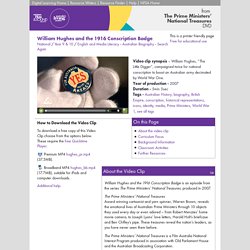
The Prime Ministers’ National TreasuresAward winning cartoonist and yarn spinner, Warren Brown, reveals the emotional lives of Australian Prime Ministers through 10 objects they used every day or even adored – from Robert Menzies’ home movie camera, to Joseph Lyons’ love letters, Harold Holt’s briefcase and Ben Chifley’s pipe. These treasures reveal the nation’s leaders, as you have never seen them before. The Prime Ministers’ National Treasures is a Film Australia National Interest Program produced in association with Old Parliament House and the Australian Broadcasting Corporation. National Statements of Learning for EnglishYear 9 Writing Students write extended or sustained texts that entertain, move, inform and persuade in print and electronic mediums.
This is an extract only. Background Information top The referendum was very narrowly defeated. Search Museum Victoria's collections. Skip to main content item HT 38691 Newspaper Cutting - The Herald, 'Special Referendum Edition', 10.15 pm, 20 Dec 1917 Public Life & Institutions, Home & Community Front page from The Herald, 'Special Referendum Edition', 10.15 pm, 20 December 1917.
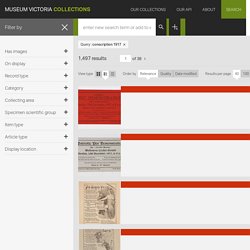
The edition announces returns for the World War I conscription referendum at Yes 95,118; No 111,858, ... item HT 504 Badge - 'For God, King, Empire', Victorian Protestant Federation, World War I, circa 1917 Home & Community, Public Life & Institutions Victorian Protestant Federation badge, 'For God, King, Empire', made circa 1917. Item ST 36610.2 Diary - Driver Claude Ewart, Egypt & France, Vol 2, World War I, 13 Mar 1916 - Aug 1917 Public Life & Institutions Black-covered diary of Driver C.